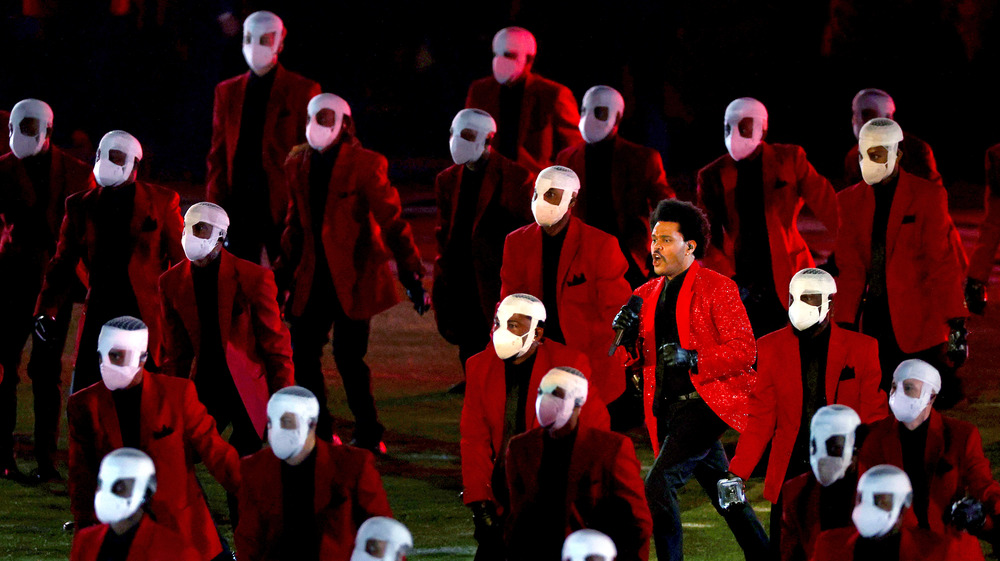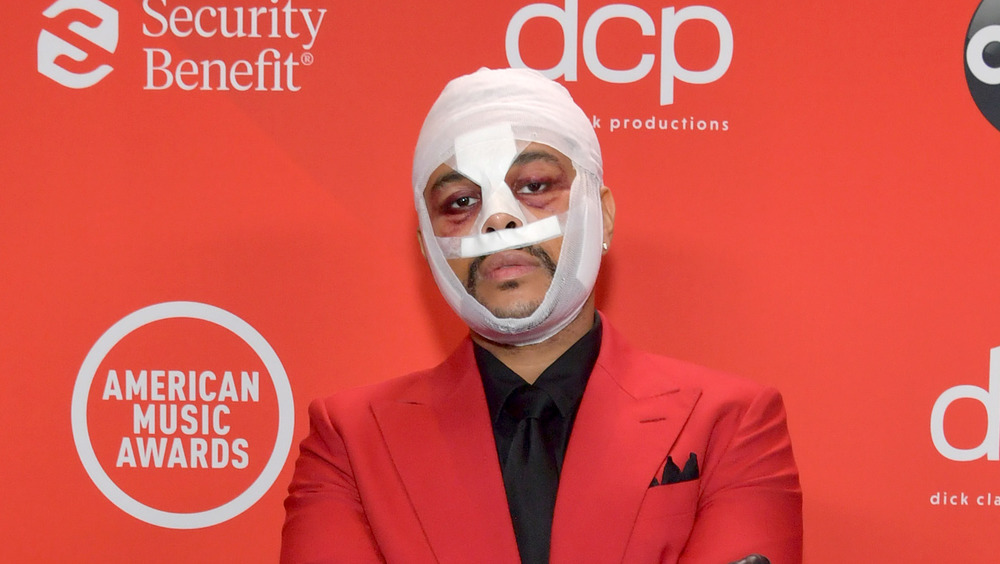The Weeknd Made A Statement With His Super Bowl Halftime Show
The Super Bowl is a huge event. The Big Game has attracted so many miscellaneous entertainment numbers and commercial opportunities that these days, it's entirely possible to watch the Super Bowl even if you aren't even moderately interested in sports. The king of non-sports-themed Super Bowl activities is, of course, the esteemed halftime show. One of the rare events that attract A-list artists to play for free, the flashy performance offers a massive audience and a huge record sales boost as a direct result of the increased attention.
For this year's Super Bowl LV, the artist who marked the game's midway point was none other than The Weeknd, Canada's gift to ominous, chart-topping alt-R&B. While The Weeknd's performance was as impressive as only a Super Bowl halftime show can be, some people were slightly thrown off by some of its aspects. Parts of the show made some people nauseous, and strangely, the backup dancers' costumes had viewers thinking of a certain Jordan Peele horror hit. Indeed, the dancers' strange face masks that resembled bandages were a pretty odd stylistic choice for a lighthearted halftime show of a major sporting event. However, it turns out that the sartorial decision has some pretty hefty lore behind it, because it's part of a narrative that the artist has been playing with for quite a while. Let's take a look at these facial wrappings, and how they were part of a statement The Weeknd made with his Super Bowl halftime show.
The Weeknd's bandaged dancers were a commentary on celebrity culture
As The Weeknd launched into a medley of hits that included (but were by no means limited to) top tracks like "Starboy," "The Hills," "Can't Feel My Face," and "Blinding Lights," he was accompanied by a host of dancers who were clad in similar red-and-black clothing as the artist himself, but wore face-obscuring bandages while The Weeknd's own visage remained uncovered.
According to Variety, the bandages are a recurring theme of the artist's After Hours album cycle. The record came out in 2019, and featured an image of The Weeknd with a broken nose, bloody face, and red and black clothing. In its wake, The Weeknd started portraying a character that, as Variety notes, goes through an absolute mangler over the course of the music videos and even live performances. In the 2020 American Music Awards, the artist appeared with a heavily bruised face and bandaged head, and the same clothes that the Super Bowl halftime show dancers were wearing. So, basically, the performance featured every dancer portraying the character normally played by The Weeknd, while the singer himself looks more conventional.
The Weeknd has explained that the bandages are intended to make a very particular statement. "The significance of the entire head bandages is reflecting on the absurd culture of Hollywood celebrity and people manipulating themselves for superficial reasons to please and be validated," he has said about his After Hours character's increasingly worrying look. This is not exactly a new theme in the artist's work — he's tinkered with horrifying aspects of Hollywood entitlement in songs like 2015's "The Hills." However, it is a pretty big message to bring to the Super Bowl stage.
The Weeknd's strange facial narrative has been going on for a while
People who have been paying attention to the artist's antics in recent times may have asked themselves: What's going on with The Weeknd's face? The musician has taken his After Hours character to some pretty strange places, ranging from the broken nose on the album cover to the strange music videos and live performances that put the poor guy through all sorts of terror and mayhem. The character's physical transformation has involved blood, bandaged noses, full facial bandages, and even a nightmarish plastic surgery makeover that made the singer seem like a chiseled, rubbery caricature of himself. Narratively, the arc seems to have depicted the character's mental decline into a jumbled mess of a man who may or may not succumb to demonic possession at one point of his doomed tale. Eat your heart out, black metal bands!
It's hardly a surprise that The Weeknd put the most brutal aspects of his After Hours storyline on the back burner for the Super Bowl halftime show. Per Billboard, the artist's manager Sal Slaiby has revealed that The Weeknd sank $7 million in the Super Bowl halftime show, so why risk it by looking like he picked a fight with each and every player in the Kansas City Chiefs and the Tampa Bay Buccaneers just before the show? However, turning the backup dancers into copies of the bandaged character was a cool move that kept The Weeknd's visuals nice and consistent. Well, at least consistent.


